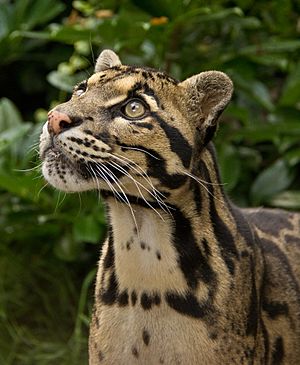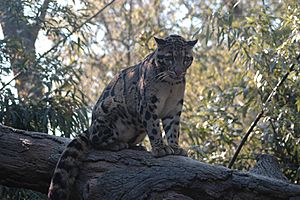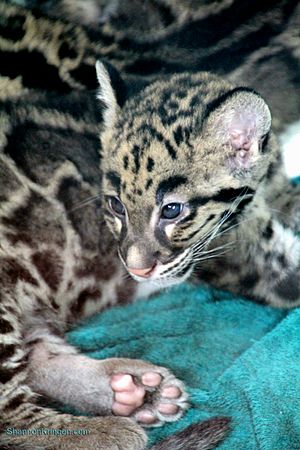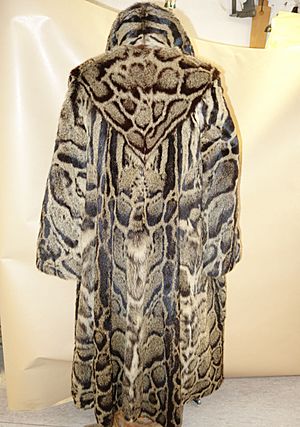Clouded leopard facts for kids
Quick facts for kids Clouded leopard |
|
|---|---|
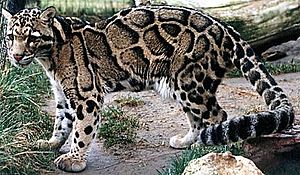 |
|
| Conservation status | |
| Scientific classification | |
| Kingdom: | |
| Class: | |
| Order: | |
| Family: | |
| Genus: | |
| Species: |
N. nebulosa
|
| Binomial name | |
| Neofelis nebulosa |
|
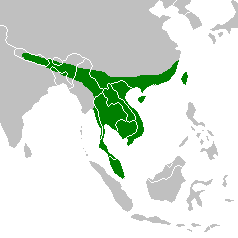 |
|
| Range map | |
The clouded leopard (Neofelis nebulosa) is a wild cat that lives in the Himalayan mountains and across mainland Southeast Asia into China. Since 2008, it has been listed as Vulnerable on the IUCN Red List. This means it is at risk of becoming endangered. There are likely fewer than 10,000 adult clouded leopards left in the wild. Their numbers are still going down. The clouded leopard is the state animal of Meghalaya, an Indian state.
Clouded leopards are good hunters. They hunt both in trees and on the ground. Scientists believe this species first appeared about 1.4 million years ago. In zoos, they usually live for about 11 years. One clouded leopard even lived to be almost 17 years old! As of 2011, there were about 222 clouded leopards living in zoos around the world.
| Top - 0-9 A B C D E F G H I J K L M N O P Q R S T U V W X Y Z |
What Does a Clouded Leopard Look Like?
Clouded leopards have beautiful fur. It is usually dark grey or yellowish-brown. This color is often covered by black and dark grey blotches. These blotches look a bit like clouds, which is how they got their name!
Their eyes are usually grayish-green or brownish-yellow. Their legs are short and strong, with wide paws. Their back legs are longer than their front legs. This helps them jump and leap very well.
They have very long, sharp canine teeth. The top canine teeth can be about 4 centimeters (1.6 inches) long or even more. People sometimes call them "modern-day sabre-tooths." This is because their canine teeth are the longest compared to their body size. They are even as long as a tiger's canine teeth!
How Do Clouded Leopards Behave?
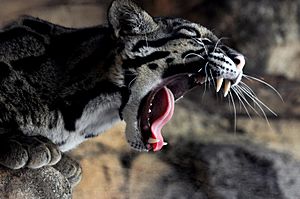
The clouded leopard is a solitary cat. This means it usually lives alone. People used to think they were rare and shy. They spend a lot of time in trees and are active mostly at night (nocturnal). They prefer to live in thick, old forests. Clouded leopards are amazing climbers. They are the best climbers among all cats!
In zoos, they have been seen climbing down tree trunks head first. They can also hang from branches using only their back paws. When they walk on thin branches, they use their long tails to help them balance and steer. They can easily jump up to 1.2 meters (4 feet) high.
They rest in trees during the day. At night, they come down to hunt. When hunting, they might sneak up on their prey. Or, they might wait quietly for prey to come to them. After they catch and eat their food, they usually go back up into the trees. There, they can digest their meal and rest safely.
It is hard to count and watch clouded leopards. This is because they are active at night and live in thick forests. They also live far apart from each other. So, we don't know much about their exact behavior or how many there are.
What Do Clouded Leopards Eat?
We don't know a lot about what clouded leopards eat. They hunt both animals that live in trees and animals that live on the ground. Some animals they are known to eat include hog deer, slow loris, brush-tailed porcupines, Malayan pangolins, and Indochinese ground squirrels. In China, they are known to eat barking deer and pheasants.
Where Do Clouded Leopards Live?
The clouded leopard lives in many places. You can find them from the Himalayan foothills in Nepal, Bhutan, and India. They also live in Myanmar, southeastern Bangladesh, Thailand, Peninsular Malaysia, Indochina, and in China south of the Yangtze River. They no longer live in Singapore and Taiwan. The last time a Formosan clouded leopard was seen in Taiwan was in 1989.
In Nepal, people thought the clouded leopard had disappeared since the 1860s. But in 1987 and 1988, four of them were found! They were found near Chitwan National Park and in the Pokhara Valley. This showed that they can live and have babies even in forests that have been changed by humans.
How Do Clouded Leopards Have Babies?
Female clouded leopards usually give birth to one to five cubs. Most often, they have three cubs. When they are born, the cubs are blind and helpless. They weigh about 140 to 280 grams (5 to 10 ounces). Unlike adult clouded leopards, the cubs' spots are solid black, not ring-shaped.
The young cubs can see after about 10 days. They start to be active when they are about five weeks old. They stop drinking their mother's milk at around three months of age. They get their adult fur pattern when they are about six months old. They probably become independent and live on their own after about 10 months. Female clouded leopards can have one litter of cubs each year.
In zoos, clouded leopards usually live for about 11 years. One clouded leopard lived to be almost 17 years old.
What Threats Do Clouded Leopards Face?
Clouded leopards face many dangers. Many of the forests where they live are becoming too small. This makes it hard for clouded leopard groups to survive for a long time. They are threatened by deforestation, which is when large areas of forest are cut down. This destroys their homes.
They are also threatened by poaching. This is when people illegally hunt them for the wildlife trade. Their skins, claws, and teeth are sold for decorations or clothing. Their bones and meat are sometimes used in traditional Asian medicines. Live clouded leopards are also caught and sold as pets.
Hunting clouded leopards is against the law in many countries. These include Bangladesh, China, India, Malaysia, Myanmar, Nepal, Taiwan, Thailand, and Vietnam. In Laos, hunting is controlled. We don't have information about their protection in Cambodia. However, these laws are often not followed very well in India, Malaysia, and Thailand. The Rukai people of Taiwan used to believe that hunting clouded leopards was forbidden.
In the United States, the clouded leopard is listed as endangered. This means it is against the law to trade these animals or any parts made from them.
Images for kids
-
Clouded leopard at Aizawl, Mizoram, India
-
A clouded leopard resting in a tree trunk at the Toronto Zoo
-
A clouded leopard at the Feline Conservation Center, Rosamond, California
See also
 In Spanish: Pantera nebulosa para niños
In Spanish: Pantera nebulosa para niños




